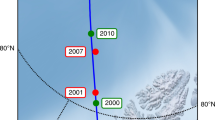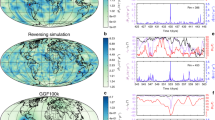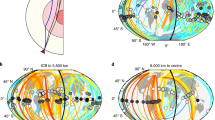Abstract
Seismic images of Earth’s inner core reveal an east–west dichotomy1,2,3. This dichotomy has been interpreted as lopsided growth, with faster solidification on one hemisphere of the inner core boundary, and slower solidification and perhaps melting on the other4,5. Today, the geomagnetic field that originates in the core is also slightly lopsided, with reconstructions revealing an offset of the dipole axis from Earth’s centre by more than 500 km. The geomagnetic dipole has moved into Earth’s Eastern Hemisphere over the past two centuries6,7 and has declined in intensity8. However, reconstructions of the magnetic field from the past 10,000 years9,10 show that the dipole previously had an offset to the west and reconstructions of the older palaeomagnetic field11,12 yield a dipole with an offset to the east. Here we use numerical simulations of the dynamo to show that lopsided inner core growth can cause persistent eccentricity of the geomagnetic field, with the best-fitting dipole axis offset in the direction of fastest inner core solidification. Our results therefore imply that faster growth may have occurred in the Western Hemisphere of the inner core during the past ten millennia. In contrast, offset of the palaeomagnetic dipole implies faster Eastern Hemisphere growth at earlier times. We suggest that a reorientation of the location of fastest inner core growth has occurred over the past 5 million years.
This is a preview of subscription content, access via your institution
Access options
Subscribe to this journal
Receive 12 print issues and online access
$259.00 per year
only $21.58 per issue
Buy this article
- Purchase on Springer Link
- Instant access to full article PDF
Prices may be subject to local taxes which are calculated during checkout





Similar content being viewed by others
References
Niu, F. & Wen, L. Hemispherical variations in seismic velocity at the top of the Earth’s inner core. Nature 410, 1081–1084 (2001).
Sun, X. & Song, X. Tomographic inversion for three-dimensional anisotropy of Earth’s inner core. Earth Planet. Inter. 167, 53–70 (2008).
Irving, J., Deuss, A. & Woodhouse, J. Normal mode coupling due to hemispherical anisotropic structure in Earth’s inner core. Geophys. J. Int. 178, 962–975 (2009).
Monnereau, M., Calvet, M., Margerin, L. & Souriau, A. Lopsided growth of Earth’s inner core. Science 238, 1014–1017 (2010).
Alboussiere, T., Deguen, R. & Melzani, M. Melting-induced stratification above the Earth’s inner core due to convective translation. Nature 466, 744–747 (2010).
Cain, J. C., Schmitz, D. R. & Kluth, C. Eccentric geomagnetic dipole drift. Phys. Earth Planet. Inter. 39, 237–242 (1985).
Gallet, Y., Hulot, G., Chulliat, A. & Genevey, A. Geomagnetic field hemispheric asymmetry and archaeomagnetic jerks. Earth Planet. Sci. Lett. 284, 179–186 (2009).
Finlay, C. C. Historical variation of the geomagnetic axial dipole. Phys. Earth Planet. Inter. 170, 1–14 (2008).
Korte, M. & Constable, C. G. Improving geomagnetic field reconstructions for 0–3 ka. Phys. Earth Planet. Inter. 188, 247–259 (2011).
Korte, M., Constable, C. G., Donadini, F. & Holme, R. Reconstructing the Holocene geomagnetic field. Earth Planet. Sci. Lett. 312, 497–505 (2011).
Johnson, C. & Constable, C. G. The time-averaged geomagnetic field as recorded by lava flows over the last 5 Ma. Geophys. J. Int. 122, 489–519 (1995).
Hatekayama, T. & Kono, M. Geomagnetic field model for the last 5 My: Time-averaged field and secular variation. Phys. Earth Planet. Inter. 133, 181–215 (2002).
Jones, C. A. in Treatise on Geophysics Vol. 8 (ed. Olson, P.) Ch. 4, 131–186 (Elsevier B.V., 2007).
Stevenson, D. J. Limits on lateral density and velocity variations in the Earth’s outer core. Geophys. J. R. Astron. Soc. 88, 311–319 (1987).
Garnero, E. J. & Helmberger, D. V. On seismic resolution of lateral heterogeneity in the Earth’s outermost core. Phys. Earth Planet. Inter. 88, 117–130 (1994).
Kustowski, B., Ekstrom, G. & Dziewonski, A. M. Anisotropic shear-wave velocity structure of the Earth’s mantle: A global model. J. Geophys. Res. 113, 806306 (2008).
Alfe, D., Gillan, M. & Price, G. Temperature and composition of the Earth’s core. Contemp. Phys. 48, 63–80 (2007).
Gubbins, D., Sreenivasan, B., Mound, J. & Rost, S. Melting of the inner core. Nature 473, 361–363 (2011).
Sumita, I. & Olson, P. A laboratory model for convection in Earth’s core driven by a thermally heterogeneous mantle. Science 286, 1547–1549 (1999).
Aubert, J., Amit, H., Hulot, G. & Olson, P. Thermo-chemical wind flows couple Earth’s inner core growth to mantle heterogeneity. Nature 454, 758–762 (2008).
Bergman, M. I. et al. Grain growth and loss of texture during annealing of alloys, and the translation of Earth’s inner core. Geophys. Res. Lett. 37, L22313 (2010).
Hulot, G., Finlay, C. C., Constable, C. G., Olsen, N. & Mandea, M. The magnetic field of Planet Earth. Space Sci. Rev. 152, 159–222 (2010).
Aubert, J. & Dumberry, M. Steady and fluctuating inner core rotation in numerical geodynamo models. Geophys. J. Int. 184, 162170 (2011).
Zhang, N., Zhong, S., Leng, W. & Li, Z-X. A model for the evolution of the Earth’s mantle structure since the Early Paleozoic. J. Geophys. Res. 115, B06401 (2010).
Olson, P. L., Coe, R. S., Driscoll, P. E., Glatzmaier, G. A. & Roberts, P. H. Geodynamo reversal frequency and heterogeneous core–mantle boundary heat flow. Phys. Earth Planet. Inter. 180, 66–79 (2010).
Christensen, U. & Aubert, J. Scaling properties of convection-driven dynamos in rotating spherical shells and application to planetary magnetic fields. Geophys. J. Int. 166, 97–114 (2006).
James, R. W. & Winch, D. E. The eccentric dipole. Pure Appl. Geophys. 66, 77–86 (1967).
Jackson, A., Jonkers, A. R. T. & Walker, M. R. Four centuries of geomagnetic secular variation from historical records. Phil. Trans. R. Astr. Soc. Lond. A358, 957–990 (2000).
Lesur, V., Wardinski, I., Hamoudi, M. & Rother, M. The second generation of the GFZ reference internal magnetic model: GRIMM-2. Earth Planets Space 62, 765–773 (2010).
Acknowledgements
We gratefully acknowledge support from grant EAR-0909622 and Frontiers in Earth System Dynamics grant EAR-1135382 from the National Science Foundation.
Author information
Authors and Affiliations
Contributions
P.O. and R.D. jointly formulated the numerical dynamo calculations and P.O. analysed their output. R.D. formulated the offset dipole calculations and analysed the archaeomagnetic, palaeomagnetic and geomagnetic data to produce the dipole offset histories. P.O. and R.D. jointly wrote the paper.
Corresponding author
Ethics declarations
Competing interests
The authors declare no competing financial interests.
Supplementary information
Supplementary Information
Supplementary Information (PDF 821 kb)
Rights and permissions
About this article
Cite this article
Olson, P., Deguen, R. Eccentricity of the geomagnetic dipole caused by lopsided inner core growth. Nature Geosci 5, 565–569 (2012). https://doi.org/10.1038/ngeo1506
Received:
Accepted:
Published:
Issue Date:
DOI: https://doi.org/10.1038/ngeo1506
This article is cited by
-
Magnetic reversals from planetary dynamo waves
Nature (2016)
-
GEOMAGIA50.v3: 1. general structure and modifications to the archeological and volcanic database
Earth, Planets and Space (2015)
-
Towards more realistic core-mantle boundary heat flux patterns: a source of diversity in planetary dynamos
Progress in Earth and Planetary Science (2015)
-
Constraints from material properties on the dynamics and evolution of Earth’s core
Nature Geoscience (2015)
-
Bottom-up control of geomagnetic secular variation by the Earth’s inner core
Nature (2013)



